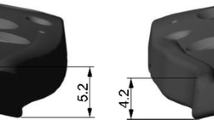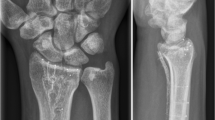Abstract
Purpose
To investigate the outcomes of proximal humeral fracture (PHF) fixation with a novel carbon-fiber-reinforced (CFR)-PEEK plate and to compare results with outcomes after conventional locked titanium plating.
Methods
Twenty-one patients (7 male, 14 female) with operative treatment of unilateral displaced PHFs (mean age, 66.8 ± 9.9 years) with a novel CRF-PEEK plate were prospectively enrolled. Patients were followed up clinically (Constant Score, Simple Shoulder Test and Simple Shoulder Value) and radiologically 3 months postoperative and again clinically 12 months postoperative. Implant-related complications were evaluated after 3 and 12 months. Results at 1-year follow-up were compared with results of 21 patients (7 male, 14 female; mean age, 67.4 ± 9.7 years) with conventional titanium locked plating by matched case–control analysis.
Results
All functional outcomes improved after CFR-PEEK plating (p < 0.05). Twelve months postoperatively, the mean age- and gender-related Constant Score was 99.8 ± 21.2%. All fractures healed by the 3-month follow-up without evidence of secondary screw perforation, fragment displacement or loss of fixation. There were no significant differences between the functional outcomes of patients with the CF-PEEK plate and patients with locked titanium plating (p > 0.05). Patients with locked titanium plating were significantly more likely to require revision surgery related to articular screw perforations (p = 0.048).
Conclusions
Fracture fixation of displaced PHFs with a novel CFR-PEEK plate resulted in good to excellent 1-year functional outcomes which were similar to outcomes of conventional locked titanium plating. The stiffer locked titanium plating was associated with a higher risk of articular screw perforations than the more elastic CFR-PEEK plate.



Similar content being viewed by others
References
Handoll HH, Ollivere BJ, Rollins KE (2012) Interventions for treating proximal humeral fractures in adults. Cochrane Database Syst Rev 12:CD000434
Burkhart KJ, Dietz SO, Bastian L, Thelen U, Hoffmann R, Mueller LP (2013) The treatment of proximal humeral fracture in adults. Dtsch Arztebl Int 110(35–36):591–597
Sproul RC, Iyengar JJ, Devcic Z, Feeley BT (2011) A systematic review of locking plate fixation of proximal humerus fractures. Injury 42(4):408–413
Thanasas C, Kontakis G, Angoules A, Limb D, Giannoudis P (2009) Treatment of proximal humerus fractures with locking plates: a systematic review. J Shoulder Elbow Surg 18(6):837–844
Siebenbürger G, Biermann N, Haasters F, Mutschler W, Ockert B (2014) Longer-term functional outcomes (median 5 years) after locked plating for displaced fractures of the proximal humerus. Obere Extrem 9(3):215–221
Lowe JC, Monazzam S, Walton B, Nelson E, Wolinsky PR (2015) How to use fluoroscopic imaging to prevent intraarticular screw perforation during locked plating of proximal humerus fractures: a cadaveric study. J Orthop Trauma 29(10):e401–e407
Fujihara K, Huang ZM, Ramakrishna S, Satknanantham K, Hamada H (2003) Performance study of braided carbon/PEEK composite compression bone plates. Biomaterials 24(15):2661–2667
Steinberg EL, Rath E, Shlaifer A, Chechik O, Maman E, Salai M (2013) Carbon fiber reinforced PEEK Optima–a composite material biomechanical properties and wear/debris characteristics of CF-PEEK composites for orthopedic trauma implants. J Mech Behav Biomed Mater 17:221–228
Kurtz SM, Devine JN (2007) PEEK biomaterials in trauma, orthopedic, and spinal implants. Biomaterials 28(32):4845–4869
Feerick EM, Kennedy J, Mullett H, FitzPatrick D, McGarry P (2013) Investigation of metallic and carbon fibre PEEK fracture fixation devices for three-part proximal humeral fractures. Med Eng Phys 35(6):712–722
Lill H, Hepp P, Korner J, Kassi JP, Verheyden AP, Josten C, Duda GN (2003) Proximal humeral fractures: How stiff should an implant be? A comparative mechanical study with new implants in human specimens. Arch Orthop Trauma Surg 123(2–3):74–81
Schliemann B, Hartensuer R, Koch T, Theisen C, Raschke MJ, Koesters C, Weimann A (2015) Treatment of proximal humerus fractures with a CFR-PEEK plate: 2-year results of a prospective study and comparison to fixation with a conventional locking plate. J Shoulder Elbow Surg 24(8):1282–1288
Rotini R, Cavaciocchi M, Fabbri D, Bettelli G, Catani F, Campochiaro G et al (2015) Proximal humeral fracture fixation: multicenter study with carbon fiber peek plate. Musculoskelet Surg 99(Suppl 1):1–8
Codman EA (1934) Fractures in relation to the subacromial bursa. In: Codman EA (ed) The shoulder, rupture of the supraspinatus tendon and other lesions in or about the subacromial bursa. Krieger Publishing, Malabar (FL), pp 313–331
Hirzinger C, Tauber M, Resch H (2011) Proximal humerus fracture: new aspects in epidemiology, fracture morphology, and diagnostics. Unfallchiurg 114(12):1051–1058 (in German)
Katthagen JC, Grabowski S, Huber M, Jensen G, Voigt C, Lill H (2016) Epidemiology and treatment reality of proximal humeral fractures at a Level-I trauma center. Obere Extremität 11(2):112–118
Hertel R, Knothe U, Ballmer FT (2002) Geometry of the proximal humerus and implications for prosthetic design. J Shoulder Elbow Surg 11(4):331–338
Constant CR, Gerber C, Emery RJH, Sojbjerg JO, Gohlke F, Boileau P (2008) A review of the constant score: modifications and guidelines for its use. J Shoulder Elbow Surg 17(2):355–361
Hawkins RJ, Kennedy JC (1980) Impingement syndrome in athletes. Am J Sports Med 8(3):151–158
Lippitt SB, Harryman DT II, Matsen FA III (1993) A practical tool for evaluating function: the simple shoulder test. In: Matsen FA III, Fu FH, Hawkins RJ (eds) The shoulder: a balance of mobility and stability. The American Academy of Orthopaedic Surgeons, Rosemont, pp 545–559
Fuchs B, Jost B, Gerber C (2000) Posterior-inferior capsular shift for the treatment of recurrent, voluntary posterior subluxation of the shoulder. J Bone Joint Surg Am 80(1):16–25
Foruria AM, Marti M, Sanchez-Sotelo J (2015) Proximal humeral fractures treated conservatively settle during fracture healing. J Orthop Trauma 29(2):e24–e30
Katthagen JC, Schwarze M, Warnhoff M, Voigt C, Hurschler C, Lill H (2016) Influence of plate material and screw design on stiffness and ultimate load of locked plating in osteoporotic proximal humeral fractures. Injury 47(3):617–624
Newton AW, Selevaratnam V, Pydah SK, Nixon MF (2016) Simple radiographic assessment of bone quality is associated with loss of surgical fixation in patients with proximal humeral fractures. Injury 47(4):904–908
Kirchhoff C, Braunstein V, Kirchhoff S, Sprecher CM, Ockert B, Fischer F, Leidel BA, Biberthaler P (2008) Outcome analysis following removal of locking plate fixation of the proximal humerus. BMC Musculoskelet Disord 12:138
Katthagen JC, Hennecke D, Jensen G, Ellwein A, Voigt C, Lill H (2014) Arthroscopy after locked plating of proximal humeral fractures: implant removal, capsular release, and intra articular findings. Arthroscopy 30(9):1061–1067
Raab C (2014) Posttraumatic limitations in range of motion of the shoulder: a multimodal therapy approach. Obere Exterm 9(4):295–300
Schai PA, Hintermann B, Koris MJ (1999) Preoperative arthroscopic assessment of fractures about the shoulder. Arthroscopy 15(8):827–835
Capriccioso CE, Zuckerman JD, Egol KA (2016) Initial varus displacement of proximal humerus fractures results in similar function but higher complication rates. Injury 47(4):909–913
Acknowledgements
The authors thank Dimitir S. Tahal for the proofreading and the language editing.
Author information
Authors and Affiliations
Corresponding author
Ethics declarations
Conflict of interest
HL has received honoraria from DePuy Synthes (Umkirch, Germany) and is consultant for Arthrex (Karlsfeld, Germany). The remaining authors declare that there was no conflict of interest.
Human and animal rights
All procedures performed in studies involving human participants were in accordance with the ethical standards of the institutional and/or national research committee and with the 1964 Helsinki Declaration and its later amendments or comparable ethical standards. This study was IRB approved.
Rights and permissions
About this article
Cite this article
Katthagen, J.C., Ellwein, A., Lutz, O. et al. Outcomes of proximal humeral fracture fixation with locked CFR-PEEK plating. Eur J Orthop Surg Traumatol 27, 351–358 (2017). https://doi.org/10.1007/s00590-016-1891-7
Received:
Accepted:
Published:
Issue Date:
DOI: https://doi.org/10.1007/s00590-016-1891-7




